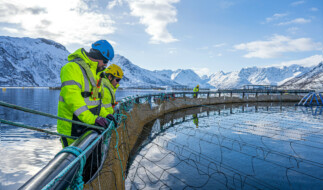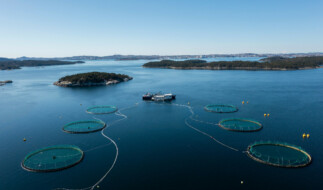Salmon: The Trojan Fish

Salmon Deep Dive
In the years I’ve spent as a chef, author, global explorer, sustainability champion, and public health educator, I’ve spent a lot of time thinking about, cooking, and serving seafood. As a result of these experiences, I’ve dedicated my work to getting more people across all demographics to eat more seafood. “A seafood evangelist” you might call me. Healthy, sustainable, and delicious food from our oceans, lakes, and rivers (and raceways, and recirculating systems…) is essential to a future in which humans thrive. It is my work now to educate culinary professionals about the stories and culinary opportunities offered by seafood. To this end, my team and our partners at Rouxbe.com, the world’s leading online culinary education platform, have developed a comprehensive online course, Seafood Literacy, which covers all aspects of seafood from production to plate. Seafood is an endlessly fascinating and nuanced topic and, to augment this curriculum, we’re delighted to launch our Salmon Deep Dive course, with the Global Salmon Initiative’s sponsorship.
Why Salmon?
Many seafood conversations quickly swim toward salmon because it offers a gateway through which we can discover and better understand the entire seafood industry. Salmon (either farmed salmon or wild) serves as an ambassador for all seafood: its widespread availability and popularity draw customers’ attention to the seafood section of a menu or lure them to the fish counter, thus uplifting the entire category. Salmon as a familiar favorite plays the role of a “Trojan fish”, helping chefs and customers alike to understand and value stories of provenance, cultures and communities of producers, and the sustainability represented by any seafood.
Over the years I’ve spent in kitchens, I’ve witnessed a dramatic change from when seafood was a generic commodity to today when chefs and customers now demand seafood seasoned with story; provenance, traceability, and sustainability are as important as quality. Although salmon serves as a common denominator for seafood, it is anything but common when it comes to the nuance and complexity of the story it carries. The evolution of this narrative has been inspiring to witness, but it hasn’t been without missteps. Farmed salmon has endured intense scrutiny, which has revealed many areas for improvement. There has been a lot of contention between wild and farmed salmon producers and the result is a murky sea of information and misinformation that persists in public forum and opinion. This is not to say that there haven’t been legitimate sustainability issues and tensions to address. But sustainability is now a defining aspect of salmon farming, from the exemplary fisheries in Alaska and the Pacific Northwest to the industry-leading farmers represented by members of the GSI. It’s important that we as the seafood industry understand that we’re in this together.
We must work to end the “farmed vs. wild” debate. Our future includes both. If we are to be a healthy society, both wild and farmed seafood must be part of our sustainable choices.Barton Seaver
The Future of Our Food
In fact, farming seafood is one of the great opportunities available to expand food production, increase quality of life and health outcomes, sustain coastal communities, and restore the resiliency and productivity of our oceans. And if we compare seafood with terrestrial proteins, measuring each by the environmental impacts of land-use alterations, greenhouse gas emissions, antibiotic use, freshwater use, and feed conversion ratios, seafood is often the better environmental choice. As we can see through the efforts of initiatives, such as the GSI, the aquaculture sector is taking great strides in improving its sustainability performance and will play a growing role in healthy and sustainable food systems and diets in years to come.
Communicating this new narrative is a great opportunity to showcase the diversity and culinary potential of this truly amazing food. A great place to start is with chefs. Because salmon is America’s favorite fish, understanding how to source, cook, serve and talk to guests about salmon is a fundamental literacy required in the modern kitchen.
There are many avenues aspiring culinarians travel to forge successful careers. Whether that path is a formal culinary school program, on-the-job bootstrapping their way up the ladder, or ascending through an established apprenticeship program such as that of the American Culinary Federation (ACF), it’s our opportunity to support learning with chef-focused and accessible content. Traditionally, given that seafood has occupied less menu space than other animal proteins, it has been an ingredient category that cooks haven’t been required or had equal opportunity to fully explore. Oftentimes, cooks have simply not had significant exposure to seafood, let alone exploring the diversity of tastes, textures, colors, flavors that seafood offers.
It is likely that any kitchen has access to dozens of salmon products (domestic, imported, wild, farmed, value add, frozen, fresh…) and that’s why, when educating chefs, it’s vital to give them information in the context of their operations that respects how they make purchasing decisions. Chefs must wade through a daunting and complex ecosystem of information that brand-focused sales efforts alone cannot help a chef navigate. Before a chef can make full sense of one salmon farm or another, they first have to understand the context of the product. That’s what our Salmon Deep Dive course delivers.
How You Can Get Involved
In a series of videos, augmented by interactive assessments and graded activities, this course teaches every aspect of salmon for the modern chef. Importantly, it speaks chef-to-chef, framing the learning through a culinary perspective. Topics showcased include the five wild species and their culinary characteristics and common wild harvest methods. We explore the world of farmed salmon and salmonid species, including production methods, culinary characteristics and regional/proprietary variations. Then we bring it to the plate to talk about best applications of culinary techniques and offer a nose-to-tail approach to utilizing the whole fish in ways that add excitement and opportunities to menus. The course offers ACF credit for successful completion. While it is geared towards the professional chef, it is not taught above the level of the general salmon consumer – perfect for all of us practicing some culinary skills at home due to the pandemic.
The bottom line is this: every sustainable seafood product has a place in modern cuisine. When we as an industry collaborate to educate and uplift the entire ingredient category, we build trust, and that’s when we build loyalty. That’s how we attract the next generation of culinarians to see seafood as a defining ingredient in their cuisine. With knowledge comes inspiration. And this course, we hope, will provide an easily accessible first step for cooks to expand seafood’s presence on their menus and to celebrate the narratives of sustainability and innovation. In addition, we want cooks to see salmon not as that ubiquitous and required ingredient on their menu, but to view consumers’ familiarity with wild and farmed salmon as an asset, allowing chefs the opportunity to display their culinary prowess and continue to keep customers craving this all-around excellent ingredient.
Please check out the course here: Salmon Deep Dive* as well as our comprehensive seafood course Seafood Literacy.
*There are a limited number of free registrations available courtesy of GSI.




